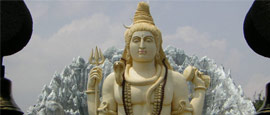Dating from the 16th century, the Bull Temple houses one of India's largest statues of Nandi, the sacred bull vehicle of Lord Shiva. The granite monolith has been stained black by centuries of being rubbed with sacred oils. Another temple with a similarly massive statue of the elephant god Ganesh sits nearby. It's a popular stop for newly-weds and devotees throng the temple daily.
Things to see in Bengaluru (Bangalore)
Tourist offices
Address: 48 Church Street, 2nd Floor, Triumph Towers, Bengaluru, 560001, India
Tel: +91 80 2558 3030.
Opening Hours:
Mon-Fri 0930-1800, Sat 0900-1300.
www.tourism.gov.inThis useful office has information on attractions across India, and piles of brochures and maps. Staff are also well informed about tourist attractions within Bengaluru and around Karnataka.
The Karnataka State Tourism Development Corporation offers a selection of passes for tourist sights but most are reserved for the media and government workers. More useful are the daily passes and monthly season tickets for the city’s buses, issued by the Bengaluru Metropolitan Transport Corporation (www.mybmtc.com).
The Iskcon Temple, 8km (5 miles) northwest of the city, is the local headquarters of the International Society of Krishna Consciousness, also known as the Hare Krishnas. It's a monumental structure that resembles a traditional Dravidian Hindu temple fused with a glass ziggurat. As well as shrines and colourful murals, there's a cinema showing films on the history of the Hare Krishna movement.
Lalbagh, meaning 'red garden', sits 4km (2.5 miles) south of the city centre. These peaceful gardens feature a slew of brightly coloured roses. Hyder Ali and his son Tipu Sultan laid out the gardens in the 18th century, and some of the ancient trees from the original opening remain. Modelled on London’s Crystal Palace, the Lalbagh’s iconic glasshouse holds one of India’s largest collections of tropical plants.
A few minutes' walk south of the city market is the Summer Palace of Tipu Sultan, the empire-building ruler of the medieval kingdom of Mysore, who was finally vanquished by an allegiance of British and Maratha troops in 1799. Although faded, the Summer Palace is still a striking building, with handsome teak pillars and traces of its original painted decoration.
Established by the British governor of Mysore in 1870, Cubbon Park is the lungs of Bengaluru - a welcomed green space in the heart of the city. The park sprawls over 120 hectares (296 acres) and around the perimeter are a string of landmark buildings, including the state legislature and the Victorian Gothic-style State Central Library and High Court of Karnataka.
Krishna Rajendra Market (also known as KR or City Market) is the city's busiest bazaar, crammed with vendors selling everything from coloured tikka powder and dried spices to strings of yellow chrysanthemums for temple offerings. It's a hive of activity, particularly in the mornings, when traders unload piles of stock for the day's trading.
Dedicated to Surya the Sun God, this temple sits among apartment blocks and attracts thousands of devotees each day, as it is believed that the deity here was brought from Badrinath, an important pilgrimage site in India. Various festivals mark Surya in India. In Bengaluru, Ratha Saptami which falls on the seventh day of the Hindu month Maagha, sees devotees celebrate Surya the Sun God with a big chariot.
Built to house the Secretariat and the State Legislature of Karnataka, the Vidhana Soudha is Bengaluru's most imposing building. It was constructed by convicts in 1954 and is a classic example of the Neo-Dravidian style, which fuses elements of European neo-classical design with onion domes and Mughal flourishes. As this is a working government building, you can only look from the outside.
The city fort was raised in 1537 as a crude mud construction, but Hyder Ali upgraded to stone in 1761. Unluckily for Tipu sultan, who used the fort as a stronghold, the British vanquished the structure during the Third Mysore War and tore down parts of the building, leaving just the gate and walls seen today. Nevertheless, it’s a peaceful spot to escape the city hubbub.
The setting is possibly more impressive than the collection at Bengaluru’s biggest museum. The handsome brick-red building was constructed in 1877 to house artefacts donated by locals during the colonial period, but the collection has been expanded to include carvings unearthed at Hampi and other archaeological sites in Karnataka. The adjacent art gallery is devoted to Sri K. Venkatappa, the court painter of the Wadiyar sultans, and provides a democratic space for regional artists to create and display.
Do you have any Feedback about this page?
© 2025 Columbus Travel Media Ltd. All rights reserved. No part of this site may be reproduced without our written permission, click here for information on Columbus Content Solutions.








 You know where
You know where